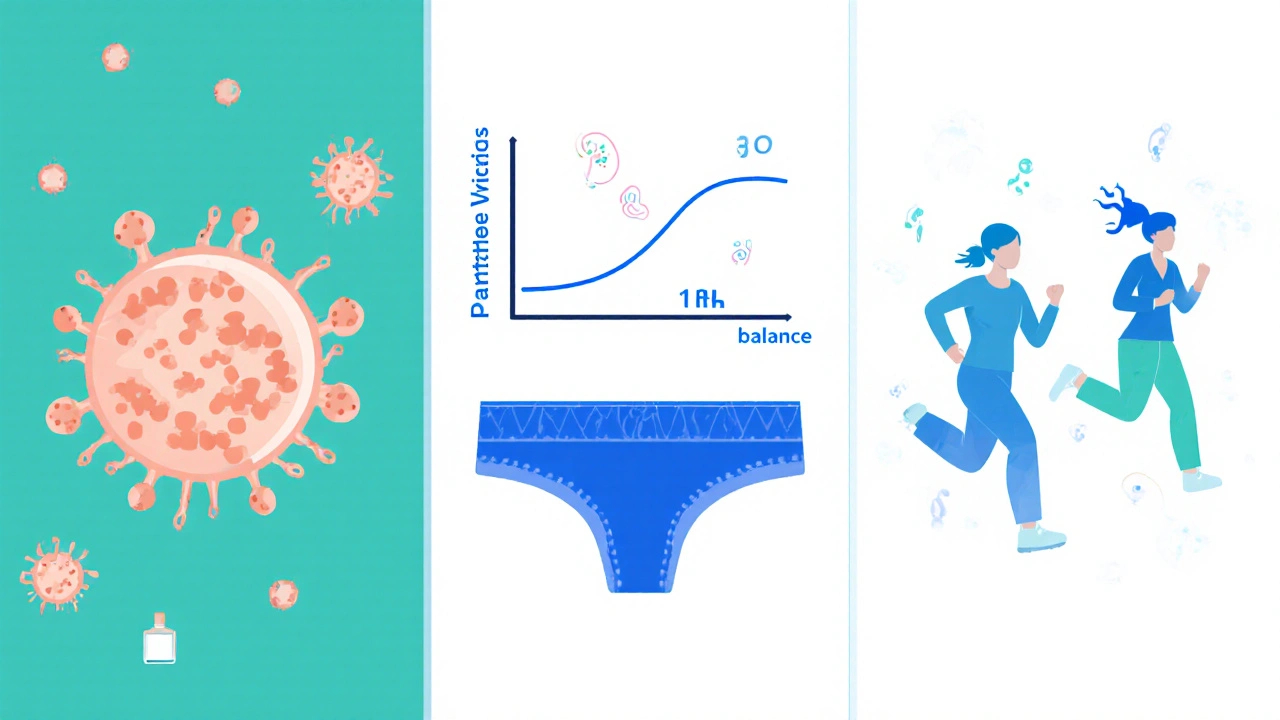Vaginal Burning During Period: Symptom Checker
Answer the questions above to get personalized recommendations for managing vaginal burning during your period.
During your monthly cycle, a sudden sting or heat in the intimate area can feel alarming and uncomfortable. This sensation-commonly referred to as vaginal burning during period a painful, burning feeling in the vagina that occurs in sync with menstruation-is more frequent than many realize, yet most people lack a clear plan for control.
What Triggers the Burn?
Before you reach for a remedy, it helps to know why the burn shows up. The menstrual cycle a monthly series of hormonal changes that prepares the body for possible pregnancy brings a roller‑coaster of estrogen and progesterone fluctuations. When estrogen dips, the natural lubrication in the vagina can thin, leaving skin more vulnerable to friction and irritants. Add to that the acidity shift caused by menstrual blood, and the delicate lining can become irritated, leading to the characteristic burning.
Common Medical Conditions That Mimic or Amplify Burning
- Yeast infection an overgrowth of Candida fungi that thrives in warm, moist environments-often worsens during periods because the extra moisture creates a perfect breeding ground.
- Bacterial vaginosis (BV) an imbalance of normal vaginal bacteria leading to a fishy odor and irritation-the pH shift during menstruation can trigger BV flare‑ups.
- Hormonal fluctuation rapid changes in estrogen and progesterone levels that affect tissue elasticity and moisture-particularly pronounced in women using certain birth‑control methods.
If the burn is accompanied by itching, thick discharge, or a strong odor, it’s more likely a infection than a simple irritation. In those cases, a medical evaluation is essential.
Lifestyle Factors That Can Spark a Burn
Even without an infection, everyday habits can set the stage for discomfort:
- Using scented pads, tampons, or washes that contain alcohol or fragrances.
- Wearing tight, non‑breathable underwear that traps heat.
- Engaging in vigorous exercise without changing out of damp clothes promptly.
- Skipping proper hygiene after menstruation, allowing residual blood to alter pH balance the acidity level of the vaginal environment, normally around 3.8-4.5.
Addressing these habits often eases the burn without medication.
Quick Relief Strategies You Can Try Tonight
When the sting hits, you need immediate comfort. Below are steps that work for most people:
- Cold compress: A clean, chilled gel pack wrapped in a soft cloth applied to the outer labia for 5‑10 minutes reduces inflammation.
- Gentle cleansing: Rinse with lukewarm water only; avoid soaps, douches, or antiseptic wipes that can strip natural oils.
- Barrier ointment: A thin layer of topical treatment over‑the‑counter creams containing zinc oxide or aloe vera that soothe irritated skin can act as a protective shield.
- Lubricant boost: Apply a water‑based lubricant a friction‑reducing gel free of glycerin and parabens before any sexual activity to minimize rubbing.
- Hydration: Drink at least eight glasses of water a day; staying hydrated helps maintain natural vaginal moisture.

When to Call a Healthcare Provider
Most burns ease within a couple of days, but seek professional help if you notice any of the following:
- Persistent pain lasting more than 48‑72 hours.
- Accompanied itching, thick white or yellow discharge, or a foul smell.
- Fever, chills, or feeling generally unwell.
- Recurrent burning every cycle despite self‑care.
A clinician can run a simple swab test to rule out yeast, BV, or other infections and prescribe targeted medication-like oral fluconazole for yeast or metronidazole for BV.
Prevention: Stay One Step Ahead
Preventing the burn often means adopting a routine that respects your body’s natural rhythms. Here’s a concise checklist you can keep by the bathroom mirror:
- Switch to 100% cotton underwear and change them daily.
- Choose unscented, breathable menstrual products; consider menstrual cups if you’re comfortable.
- After your period, gently pat the area dry-don’t rub.
- Incorporate a probiotic‑rich diet (yogurt, kefir, fermented veggies) to support healthy vaginal flora.
- Schedule a yearly gynecological exam to catch any underlying issues early.
Home Remedies vs. Over‑the‑Counter Options
| Approach | Typical Cost (US$) | Speed of Relief | Potential Side Effects | Best For |
|---|---|---|---|---|
| Cold compress + plain water rinse | 0‑2 | Immediate to 30min | None if done cleanly | Mild irritation, quick fix |
| Apple cider vinegar soak (1cup in warm water) | 1‑3 | 30min‑1hr | May sting if skin broken | Balancing pH, mild infections |
| Probiotic yogurt application | 2‑4 | Several hours | Rarely allergic reactions | Boosting good bacteria |
| OTC zinc‑oxide cream | 5‑10 | 15‑30min | Possible temporary tingling | Barrier protection, persistent burns |
| OTC antifungal tablet (e.g., fluconazole 150mg) | 12‑20 | 24‑48hr (systemic) | Rare GI upset | Confirmed yeast infection |
| OTC metronidazole gel (0.75%) | 15‑25 | Within 12hr | Dryness, mild burning initially | Confirmed BV |
Bottom Line
Vaginal burning during your period is usually a mix of hormonal shifts, moisture changes, and everyday irritants. Simple hygiene tweaks, quick at‑home comforts, and a short list of OTC options cover most scenarios. If symptoms linger or are accompanied by discharge, smell, or fever, a healthcare professional can pinpoint the exact cause and give you a precise prescription.
Frequently Asked Questions
Can menstrual cups cause vaginal burning?
Most cups are made of medical‑grade silicone and are safe, but if a cup is too tight or left in too long, it can create friction and moisture buildup, leading to a burning sensation. Always follow the manufacturer’s replacement schedule and ensure a proper fit.
Is it normal for the burn to get worse after sex?
Yes. During menstruation, lubrication can be reduced, so friction from intercourse may aggravate already sensitive tissue. Using a water‑based lubricant and communicating with your partner can dramatically cut down the sting.
Should I stop using scented tampons?
Absolutely. Fragrances and dyes are common irritants and can upset the natural pH, making burning more likely. Opt for unscented, cotton‑based products instead.
Can stress trigger vaginal burning?
Stress can influence hormone levels, especially cortisol, which in turn can affect estrogen balance and tissue sensitivity. Managing stress through gentle exercise or mindfulness may reduce frequency of burns.
How long should I wait before trying an OTC antifungal?
If you suspect a yeast infection-typically marked by thick white discharge and itching-start an OTC antifungal after confirming the symptoms. If there’s any doubt, a quick swab test at your doctor’s office ensures you choose the right treatment.

Moore Lauren
October 5, 2025 AT 01:13Try switching to cotton underwear and unscented pads for instant relief
Jonathan Seanston
October 5, 2025 AT 23:26I know it’s personal but I once dealt with the same burning and I simply quit scented tampons and it helped fast
Chelsea Hackbarth
October 6, 2025 AT 23:03Vaginal burning is a real issue that many people overlook 😟. The hormonal dip during menstruation can thin natural lubrication and make tissues vulnerable 🔬. Moisture from menstrual flow changes the pH, creating a perfect environment for yeast overgrowth 🍞. If you notice itching or a thick discharge, that’s a red flag for infection 🚩. Simple hygiene tweaks like using plain water to cleanse can calm the irritation 🤲. Switching to 100 % cotton underwear helps keep the area breathable and dry 🌬️. Unscented, fragrance‑free pads or tampons reduce chemical irritants dramatically 🚫. A cold compress applied for ten minutes can shrink inflamed blood vessels quickly ❄️. Staying well‑hydrated maintains overall tissue health and moisture balance 💧. Probiotic‑rich foods support a healthy vaginal flora from the inside out 🥛. Over‑the‑counter zinc‑oxide creams form a protective barrier that soothes raw skin 🛡️. If symptoms persist beyond three days, see a healthcare professional for a proper swab test 🩺. Prescription antifungals work fast for confirmed yeast infections, often clearing symptoms in 24‑48 hours 💊. For bacterial vaginosis, metronidazole gel can provide relief within half a day 🧴. Remember, prevention is key: keep the area clean, dry, and free from scented products for lasting comfort 😊.
Adam Shooter
October 8, 2025 AT 00:03The etiopathogenesis of dysesthetic sensations during menses can be delineated via a multifactorial paradigm integrating endocrinological oscillations, vulvovaginal microbiome dysbiosis, and exogenous irritant exposure; consequently, a reductive heuristic predicated solely on “hygiene” obfuscates the underlying iatrogenic variables, thereby necessitating a rigorous differential diagnosis encompassing candidal overgrowth, bacterial vaginosis, and estrogen‑deficiency‑mediated mucosal atrophy, each of which mandates a distinct therapeutic algorithm calibrated to the pathogenetic substrate.
Fae Wings
October 9, 2025 AT 02:26Oh wow, that sounds intense 😢. I totally get how overwhelming it can feel when everything’s explained in such dense terms. It’s amazing how a simple cold pack or a switch to cotton can make a big difference 😊.
Anupama Pasricha
October 10, 2025 AT 06:13From a holistic perspective, addressing vaginal burning involves optimizing the acidic milieu through probiotic supplementation, ensuring barrier protection with breathable textiles, and eliminating fragrance‑laden menstrual products; this integrative approach promotes microbiological equilibrium and mitigates mucosal irritation without resorting to aggressive pharmacotherapy.
Bryce Charette
October 11, 2025 AT 12:46Just a quick note: it’s “probiotic supplementation,” not “probiotic supplemention,” and “textiles” is plural, so you might say “breathable textiles.” Otherwise great advice!
Christina Burkhardt
October 12, 2025 AT 22:06Everyone, remember that consistent hydration and a balanced diet rich in lactobacilli can fortify your natural defenses; if you experience persistent burning, a brief consultation with your clinician can rule out infection and tailor a treatment plan that respects your comfort and lifestyle 😊.
Rebecca Bissett
October 14, 2025 AT 10:13Indeed!!!, the importance of hydration cannot be overstated,,, and remember!!!, always check the label for fragrance-free products,,, otherwise you risk!!!, irritating the delicate mucosa,,, which can lead!!!, to prolonged discomfort!!!
Michael Dion
October 16, 2025 AT 01:06Meh not convinced
Trina Smith
October 17, 2025 AT 18:46Considering the cyclical nature of hormonal flux, one might view vaginal burning as a reminder of the body’s intricate interplay between endocrine signals and microbial ecosystems; embracing this perspective can transform discomfort into an opportunity for mindful self‑care and deeper bodily awareness 🌿.
Sharon Cohen
October 19, 2025 AT 15:13That’s a stretch, it’s just irritation, not some profound lesson.
Rebecca Mikell
October 21, 2025 AT 14:26I appreciate the balanced insights shared here; it’s helpful to have both practical tips and scientific context in one place.
Jason Divinity
October 23, 2025 AT 16:26While your recommendations are generally sound, please note that “unscented” should be hyphenated as “unscented,” and “OTC” is an abbreviation that should be introduced before use; additionally, “cold compress” is singular and therefore requires the article “a” preceding it. These minor corrections will enhance the clarity of your guidance.
Sarah Arnold
October 25, 2025 AT 21:13Got it, thanks for the clarification! I’ll make sure to use the correct hyphenation and article usage in future posts.
Elizabeth González
October 28, 2025 AT 03:46For optimal prevention, adhere to a regimen of regular cotton underwear changes, avoid scented menstrual products, maintain adequate hydration, and incorporate probiotic‑rich foods; these measures collectively support vaginal health and reduce the likelihood of period‑related burning.
Edward Glasscote
October 30, 2025 AT 14:06Sounds good, I will try that.
Gaurav Joshi
November 2, 2025 AT 03:13Honestly, that advice is oversimplified; without addressing underlying hormonal imbalances or potential infections, simple changes may not resolve the issue for many users.